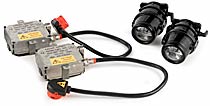Halogen Light Bulbs
Halogen bulbs are the most common type of headlight bulb in today's automobile industry. Halogen bulbs contain a gas mixture that includes halogen compounds that help some of the tungsten particles return to the filament as it cools. Thanks to this process, the light output of the halogen bulb remains almost constant throughout the life of the bulb. However, despite the chemical process taking place within the bulb, the tungsten wire is slowly used up and ultimately limits the life of the bulb.
Note: A very small amount of xenon gas is also used in some halogen bulbs to produce a whiter light and to help keep deposits off the glass tube.
Xenon High Intensity Discharge (HID) Light Bulbs
Xenon High Intensity Discharge (HID) light bulbs are filled with xenon gas and use a stabilized arc of electricity to generate a whiter light source than is available from a standard halogen bulb. This type of lighting system uses a ballast to initiate and maintain the proper bulb voltage during operation.
Xenon lamp technology is currently the most advanced development in the field of motor vehicle light systems. Vehicles equipped with xenon bulbs as Original Equipment improve visibility both at night and in poor weather conditions compared to halogen lamps. Xenon low-beam headlights provide brighter and wider road illumination and xenon high-beam lights provide longer range. Fortunately, aftermarket Xenon HID driving light kits are available for those vehicles not equipped with Original Equipment xenon light systems.
Xenon light has decisive advantages over light from conventional and halogen bulbs. Xenon provides more light to better accommodate natural human visual habits and they give off a "light color" very similar to daylight.
Xenon bulbs produce more than twice the light output of a modern H7 halogen bulb, although it only requires around 2/3 of the energy. Road illumination is brighter and wider with xenon light. Drivers become tired less quickly and driving becomes more relaxed. It is not the act of seeing which leads to tiredness and other negative effects, but the concentration involved. A road that is illuminated more brightly and widely by xenon light reduces the amount of concentration needed, so that drivers do not become tired as quickly and can more easily concentrate on driving. Dangers are recognized more easily, especially those at the curb and shoulder areas, as well as, far ahead of the vehicle in the center of the road. Pedestrians or cyclists can be seen better, as can traffic signs along the edge of the road.
Additionally, xenon bulbs radiate light that has a "light color" very similar to daylight that is welcomed by the human eye and increases contrast and ease of color identification. In poor weather conditions -- such as rain, fog or snow -- drivers also have much improved spatial vision, which means that the driver's ability to orient themselves is easier despite adverse conditions. This means an enormous gain in safety and driving comfort.
Was this post helpful?
370 of 810 people found this post helpful


